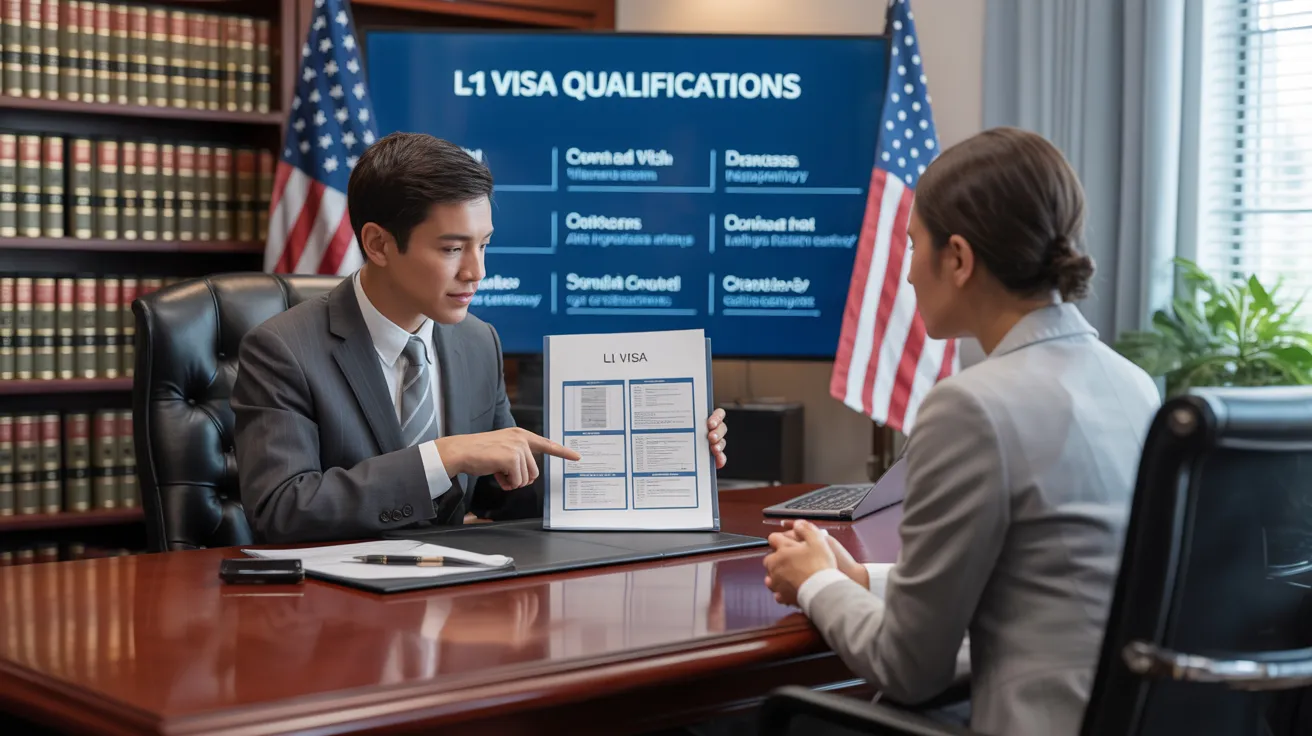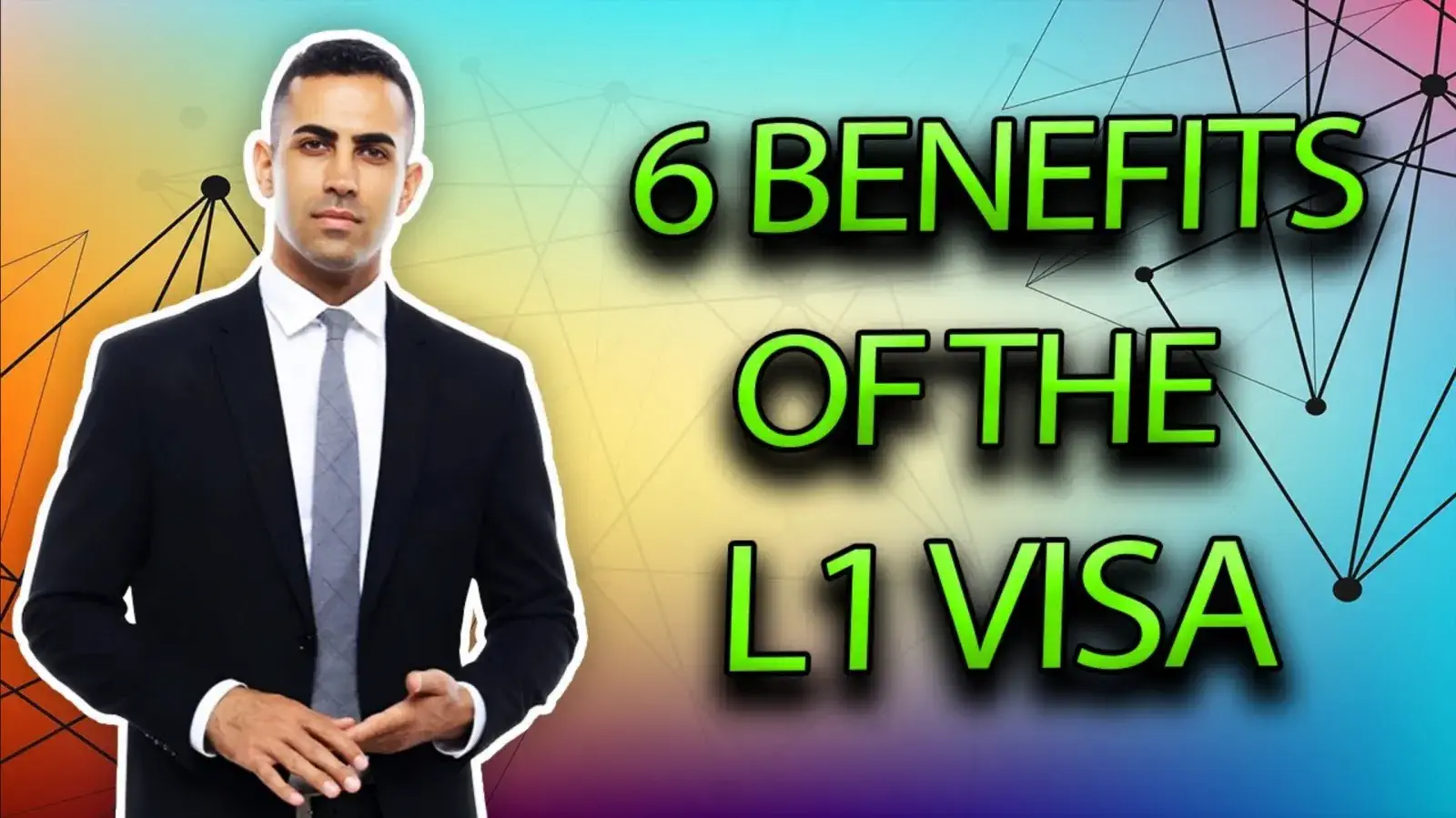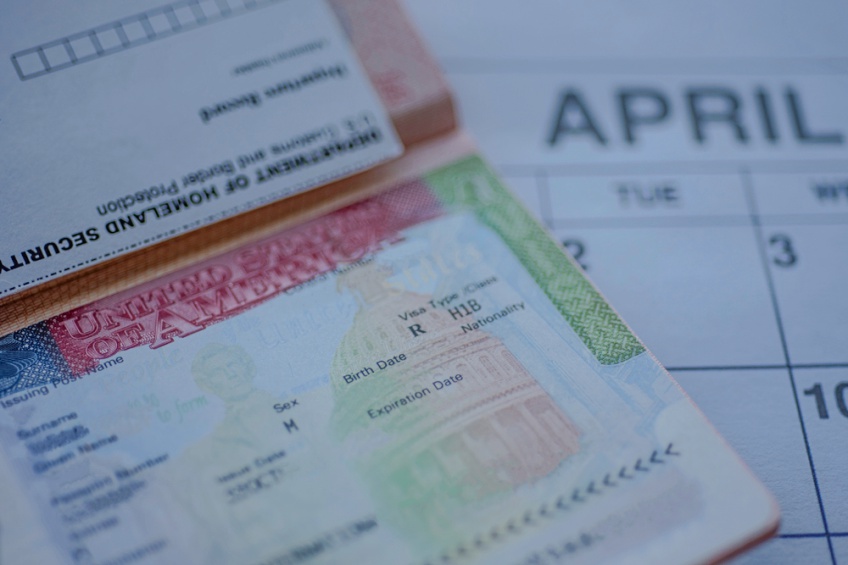Opening Opportunities: A Comprehensive Overview to the L1 Visa Process
The L1 visa procedure offers a vital path for international business seeking to move vital staff members throughout boundaries. Understanding the subtleties of qualification criteria, the differences between L-1A and L-1B visas, and the complexities of the application process can substantially influence a candidate's success. Nonetheless, steering this facility landscape is not without its difficulties, and cautious interest to documentation and employer sponsorship is essential. As we check out the key components of this procedure, the approaches for getting rid of possible challenges will come to be obvious, revealing just how notified prep work can open a world of opportunities.
Recognizing the L1 Visa
Understanding the L1 visa involves acknowledging its significance as a crucial tool for international business seeking to move skilled staff members between international workplaces. This non-immigrant visa category facilitates the movement of execs, managers, and specialized expertise employees to the USA, thus making it possible for companies to keep operational connection and harness global ability efficiently. The L1 visa is separated into 2 main classifications: L-1A for supervisors and execs, and L-1B for employees possessing specialized knowledge.The L1 visa serves an important duty in enhancing a firm's one-upmanship in the international marketplace - L1 Visa Requirements. By enabling firms to move their vital workers, companies can assure that crucial projects are managed by certified people who are currently accustomed to the firm's culture and operational procedures. This interior transfer mechanism not only cultivates knowledge sharing however also advertises development and partnership across borders.Moreover, the L1 visa is frequently preferred for its reasonably straightforward application process contrasted to other visa categories, as it enables for twin intent, permitting holders to seek permanent residency while on a short-lived copyright. This feature makes the L1 visa especially appealing for both employers and workers, as it streamlines the pathway for knowledgeable professionals to establish long-term residency in the USA
Eligibility Standards
Eligibility for the L1 visa hinges on a number of crucial standards that guarantee both the worker and the company satisfy specific certifications. This non-immigrant visa is designed for multinational business to move staff members from international workplaces to united state counterparts.Firstly, the employer should be a qualifying company, which consists of a moms and dad company, branch, associate, or subsidiary of a united state service. The firm must have been doing organization for at the very least one year both in the united state and abroad. This assures that the company has sufficient operational stability and a genuine presence.Secondly, the employee should hold a managerial, exec, or specialized expertise placement. For L1A visas, the applicant must show supervisory or executive qualifications, while L1B visas focus on specialized expertise pertaining to the company's products, solutions, or procedures. In addition, the staff member needs to have benefited the international entity for at the very least one continuous year within the last three years before their application.Lastly, the employee's role in the united state have to straighten with their previous setting, guaranteeing that their abilities and proficiency are leveraged for the firm's benefit.
Sorts Of L1 Visas
The L1 visa category consists of two primary types designed to promote the transfer of employees within international companies: the L1A visa for supervisors and executives, and the L1B visa for staff members with specialized knowledge. Each type offers distinctive objectives and has particular qualification criteria.The L1A visa is tailored for individuals that hold managerial or executive positions within a business. This visa makes it possible for high-level staff members to move to a united state branch, subsidiary, or associate of the exact same company. Candidates for the L1A visa should demonstrate that they have been utilized in a supervisory or executive capacity for at the very least one continual year within the past 3 years prior to their application. Furthermore, this visa offers a longer period of remain, originally approved for 3 years, with the opportunity of extensions for as much as 7 years.In comparison, the L1B visa is intended for experts with specialized knowledge relevant to the firm's products, services, or procedures. To certify, applicants must prove that their expertise is vital to the organization which they have actually worked for at the very least one continual year within the last 3 years in a duty that required this specialized knowledge. The L1B visa is initially given for three years, with expansions readily available for approximately 5 years.Both visa kinds are essential for business seeking to enhance their global procedures by leveraging skilled workers, thus promoting innovation and performance within the U.S. market.
Application Process
Guiding via the L1 copyright procedure entails a number of important actions that should be diligently followed to ensure a successful outcome. The procedure begins with the united state employer, who have to first establish qualification by showing a qualifying partnership with the foreign entity and validating that the employee satisfies the specific requirements for the L1 visa classification being sought.Once qualification is verified, the company initiates the process by filing Kind I-129, the Petition for a Nonimmigrant Employee, with the U.S. Citizenship and Immigration Solutions (USCIS) This kind should be come with by a thorough description of the task obligations to be performed, the business framework of both the united state and foreign entities, and the worker's certifications. It's important to validate that all information is exact and total, as omissions or errors can lead to delays or denials.Upon authorization of the I-129 petition, the following action involves the worker obtaining the L1 visa at an U.S. embassy or consulate in their home country. This stage needs the completion of Form DS-160, the Online Nonimmigrant copyright, and setting up an interview. Throughout the interview, the applicant should offer evidence sustaining their certifications and the company's petition.After the visa is provided, the staff member can enter the United States to operate in the assigned duty. Overall, careful prep work and adherence to each step of the application procedure are vital for an effective L1 visa outcome.
Called for Paperwork

Crucial Types Required
Navigating the L1 Visa process calls for cautious interest to the important forms and documents necessary for a successful application. The key kind needed is the Kind I-129, Request for a Nonimmigrant Employee, which must be completed and sent by the U.S. employer. This form lays out the details of the work offer and the certifications of the employee seeking the L1 Visa.Alongside Kind I-129, the applicant will require to total Kind I-539 if accompanying member of the family are also looking for visas. Furthermore, the company has to provide evidence of the certifying relationship in between the united state entity and the international entity, commonly necessitating the entry of corporate papers such as articles of incorporation or economic statements.Moreover, it is vital to consist of the L Classification Supplement to Kind I-129, which specifies the kind of L Visa being requested-- either L-1A for managers and execs or L-1B for employees with specialized understanding. Ultimately, applicants need to guarantee that all types are signed and dated properly, as incomplete entries can bring about hold-ups or rejections. Properly putting together these crucial types lays the structure for a smoother L1 copyright procedure.

Supporting Evidence Requirements
Sustaining documents is important for a successful L1 copyright, as it validates the claims made in the petition. Applicants need to offer a series of documents to show qualification for the visa, which is categorized into 2 main kinds: proof of the certifying connection in between the united state and foreign entities and proof of the candidate's qualifications.To establish the connection, applicants ought to send paperwork such as company business charts, economic statements, and proof of possession. These papers validate that the international business has a certifying relationship with the united state employer, whether as a parent firm, subsidiary, branch, or affiliate.For the applicant's qualifications, essential files include a comprehensive employment letter from the international company, describing the applicant's work title, tasks, and period of employment. In addition, educational qualifications, such as degrees and diplomas, need to be supplied to verify the applicant's knowledge in the pertinent area.
Employer Sponsorship Papers

Common Difficulties
Maneuvering the L1 visa process offers a number of usual obstacles that applicants must know. Secret concerns commonly include rigid documents requirements, potential hold-ups in handling times, and the necessity for strict legal compliance. Recognizing these obstacles can assist candidates better prepare and minimize dangers throughout their copyright journey.
Paperwork Demands
The L1 copyright process frequently presents substantial challenges connected to documentation needs. Candidates must offer comprehensive documentation to establish qualification, which can bring about confusion and prospective delays. Trick documents consist of proof of a qualifying partnership in between the united state and foreign employer, evidence of the applicant's employment history, and thorough information about the job role in the U.S.One common difficulty is gathering sufficient evidence to show the nature of the qualifying connection. Business usually struggle to existing clear organizational graphes or monetary statements that illustrate the connection in between the entities. Furthermore, ensuring that letters of assistance from companies accurately reflect the applicant's job responsibilities and qualifications is crucial, as vague summaries can lead to denials.Another problem arises from the demand for comprehensive job summaries that line up with the L1 visa groups. Candidates should express not just their current role yet likewise their managerial or specialized expertise duties clearly. This necessitates a thorough understanding of both the candidate's setting and the regulative language used in L1 applications.
Handling Dead Time
Experiencing delays in handling times is a typical challenge encountered by L1 visa applicants, commonly leading to disappointment and unpredictability. A number of factors add to these hold-ups, including high application quantities, enhanced analysis of applications, and administrative stockpiles within the U.S. Citizenship and Migration Services (USCIS) Candidates might find that handling times can differ substantially relying on the service facility handling their application, as each center has its very own work and effectiveness degrees. Furthermore, the intricacy of the applicant's instance, such as the requirement for substantial documentation or information, can further prolong wait times.In some circumstances, issues connected to the candidate's current immigration condition or previous visa history may additionally result in added hold-ups, as USCIS might call for further evaluation or information. It is vital for candidates to stay aggressive during this duration, maintaining L1 copyright copyright open interaction with their companies and lawful representatives to deal with any prospective problems promptly.Understanding these processing time difficulties can aid L1 visa applicants prepare for feasible hold-ups and minimize the impact on their shift and occupation strategies. Persistence and diligence are necessary merits in steering this detailed procedure.
Lawful Conformity Issues
Many L1 visa applicants experience lawful conformity problems that can complicate their trip towards obtaining the visa. Comprehending and sticking to the certain laws established by the united state Citizenship and Migration Solutions (USCIS) is important. Typical difficulties include demonstrating the qualifying partnership between the foreign and U.S. companies, as well as verifying that the candidate has the requisite specialized expertise or supervisory capacity.Additionally, candidates have to offer thorough documentation detailing their job obligations, corporate structure, and financial practicality of the U.S. entity. Poor or incorrect documents can lead to delays and even denials. Companies have to also guarantee that they abide by labor regulations, including wage and functioning problem requirements, which can affect visa eligibility.Another typical issue includes maintaining conformity with the terms of the visa once granted. Adjustments in work status, job obligations, or business framework can require amendments to the visa, which if not attended to immediately can result in lawful problems. As an outcome, staying notified concerning compliance requirements and looking for legal counsel when necessary is vital to navigate the intricacies of the L1 visa procedure successfully.
Tips for Success
Success in the L1 copyright procedure frequently hinges on careful preparation and focus to information. To boost your possibilities of authorization, begin by completely recognizing the eligibility needs for both the L1A and L1B visa categories. Assess whether your placement at the firm certifies as managerial, exec, or specialized understanding, as this classification notably influences your application.Next, gather substantial documents that corroborates your cases. This includes organizational graphes, detailed task summaries, and evidence of the company's operational framework. Clear and succinct evidence of the qualifying connection between the U.S. entity and the foreign entity is crucial. Verify that all papers are arranged practically and presented in an expert manner, as this shows your dedication and severity about the application.Engage the services of a seasoned migration lawyer that focuses on L1 visas. Their expertise can show invaluable, assisting you via complicated guidelines and assuring that all documentation complies with current laws. In addition, plan for the interview by practicing response to common questions and preparing to review your duty and payments to the business comprehensive.
Regularly Asked Questions
Can Household Members Accompany the L1 Visa Owner?
Yes, family members of L1 visa holders, consisting of partners and single youngsters under 21, can go along with the primary visa owner. They might likewise make an application for L2 visas, which permit them to reside in the United States.
For How Long Can I Remain On an L1 Visa?
The L1 visa permits preliminary remains of as much as 3 years, with the opportunity of extension. L1A visa owners may remain for a maximum of 7 years, while L1B visa owners can stay for five years.
Can L1 Visa Owners Look For a Permit?
Yes, L1 visa owners can make an application for a copyright. L1 Visa Requirements. They may pursue permanent residency through employment-based categories, typically calling for sponsorship from their company, supplied they satisfy the required qualifications and documentation demands
What Happens if My L1 copyright Is Refuted?
If your L1 copyright is rejected, you may receive a notification detailing the factors for rejection. You can look for to appeal the decision, reapply, or discover alternative visa choices based upon your scenarios.
Are There Any Kind Of Traveling Limitations With an L1 Visa?
An L1 visa usually enables global traveling; however, re-entry to the united state rests upon maintaining legitimate status. Tourists need to guarantee compliance with visa problems to avoid difficulties upon return
Final thought
